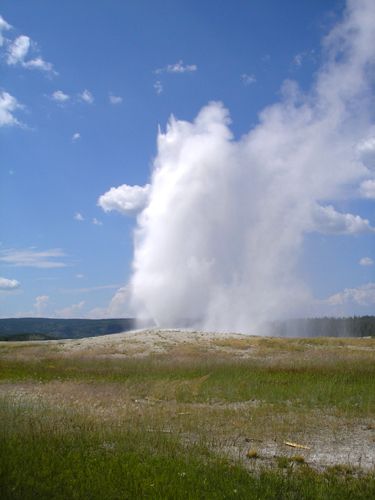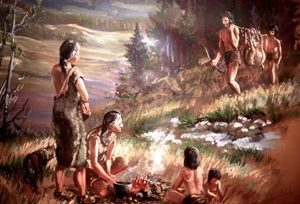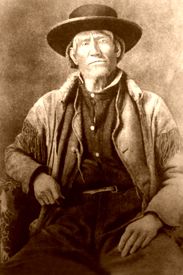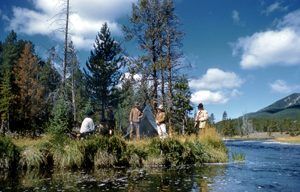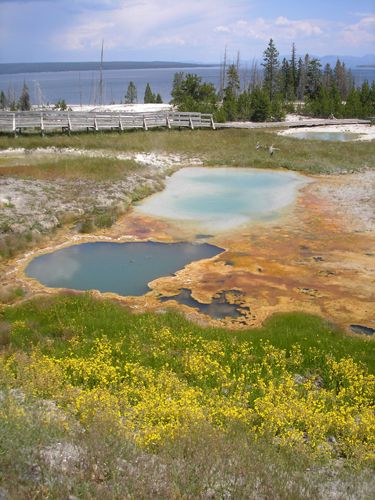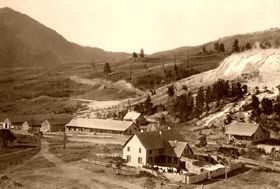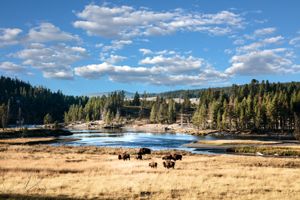*Update April 2023 – Yellowstone National Park Road Closures. Visit the National Park Service Website Here for updates.
Yellowstone, the oldest U.S. National Park, attracts three million visitors yearly to experience its many wonders. In Montana, Wyoming, and Idaho, Yellowstone covers 3,470 square miles, primarily in the northwest corner of Wyoming. Famous for its geysers, hot springs, and free-ranging wild animals, Yellowstone is a seasonal wonder, offering an abundance of activities for all ages and interests!
Some 640,000 years ago, Yellowstone and its scenic views were formed when a colossal volcanic eruption ejected an immense volume of ash covering the western U.S., much of the Midwest, northern Mexico, and some areas of the eastern Pacific Coast. Leaving a volcanic depression some 30 miles wide by 45 miles long, the eruption created what the early American pioneers referred to as “the place where hell bubbles up.”
Geothermal wonders, such as Old Faithful, are evidence of one of the world’s largest active volcanoes, which typically erupts about every 600,000 years.
Though providing spectacular features that bemused and befuddled the park’s earliest visitors, the volcano is known to have been the largest ever occurring on Earth, resulting in the worldwide population falling to as little as 10,000 people.
The park was named for the yellow rocks seen in the rocky cliffs along the northern portion of the Yellowstone River. The iron in the rocks casts causes them to cast a yellow tint that the Native Americans first called “Mitzi-a-dazi,” or the “River of Yellow Rocks.” Later French fur trappers translated this to “Yellow Rock” or “Yellow Stone.”
Gathered from archeological evidence, Native American history here is said to date back as far as 12,000 years. These earliest people were known to have been primarily hunter-gathers who utilized significant amounts of obsidian to make cutting tools and weapons. They may also have practiced some crude farming activities. Arrowheads made of Yellowstone obsidian have been found as far away as the Mississippi Valley, indicating that a regular obsidian trade existed between Yellowstone Native Americans and tribes further east.
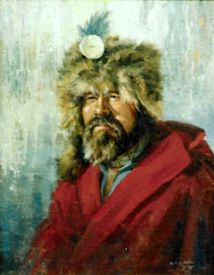
John Colter
In 1806, when the Lewis and Clark Expedition moved through the area, a man named John Colter left the expedition, joining a group of fur trappers. Colter is credited as being the first non-Native American to visit the region and make contact with the Indians. These Native Americans, called Sheepeaters, were a band of Shoshone who survived by hunting for bighorn sheep and fishing the headwaters of the Snake, Madison, and Yellowstone Rivers.
Colter spent the winter of 1807-08 traveling, trapping, and exploring Yellowstone before moving down into what would be known as Jackson Hole and crossing the Grand Tetons into Idaho. However, his adventure ended when in the fall of 1808, he was captured by Blackfeet Indians. Stripped naked, Colter was somehow able to escape. When he returned to Missouri from his adventures, people mocked his stories of steam rising from the earth and boiling mud as mad hallucinations, earning Yellowstone its first name as “Colter’s Hell”.
In 1857, mountain man Jim Bridger led an expedition to Yellowstone. He also returned with stories of boiling springs and spouting water; however, because he had already earned a reputation as one to tell “tall tales,” his accounts were largely ignored.
Tall tales or not, the stories told by Colter and Bridger aroused the interest of explorer and geologist Dr. Ferdinand V. Hayden. In 1859, Hayden began a survey of the upper Missouri River region, accompanied by U.S. Army surveyor W.F. Raynolds and Jim Bridger acting as a guide.
Unfortunately, the party could not reach the Yellowstone region due to heavy snow. Afterward, the Civil War stopped all attempts to explore the region further, and Hayden would not be able to fulfill his mission to explore the area for another eleven years.
Before Hayden could return another expedition was organized by a group of Montanans in 1870. Referred to as the Washburn-Langford-Doane Expedition, the group was led by the surveyor-general of Montana Henry Washburn. Also part of the group was a man named Nathaniel P. Langford, who would later become known as “National Park Langford” and the first superintendent of Yellowstone Park. Spending about a month exploring the region, the expedition named many of the sites of interest, that continues to be used today.
In the meantime, Dr. Hayden had been working with the government to sponsor a second expedition to Yellowstone and discussions were already in progress to make Yellowstone a National Park. In early 1871, the U.S. Geological Survey sponsored Hayden’s second trip to the park. Along with Hayden were naturalists, geologists, a landscape artist, and two photographers.
Closely following the Washburn-Langford-Doane Expedition, the group compiled a comprehensive report on Yellowstone, including photographs and paintings which helped to convince the U.S. Congress to create Yellowstone National Park on March 1, 1872.
Nathaniel P. Langford, who had been on the earlier 1870 expedition was appointed as the first superintendent of Yellowstone. However, there was no money available for a salary, so he was forced to make his living elsewhere. During his five year term, he entered the park only two times, the first as a guest for yet another Hayden Expedition in 1872, and the second to evict a man who claimed ownership of Boiling River, a natural spring within the park.
The second superintendent was a man named Philetus Norris, who volunteered for the position. Reporting on the problems that he witnessed first hand, Congress finally provided funds for a salary, as well as a minimal amount to operate the park.
Additional superintendents followed, but without adequate help, Yellowstone’s natural resources were being destroyed as poachers killed animals, souvenir hunters broke off pieces of geological formations, and developers established numerous tourist camps.
As a result, the park turned to the U.S. Army for help. In August 1886, the army arrived to begin what would be more than 30 years of military presence at Yellowstone.
After living in temporary frame buildings at Camp Sheridan and enduring five cold winters, the Army realized there was no end in sight for the assignment and asked Congress for funds to establish a permanent post.
Fort Yellowstone was completed by late 1891 and as more troops were needed, additional buildings were constructed including officers’ quarters, a guardhouse, headquarters, stables and barracks for the enlisted men.
At the height of the Army’s presence in Yellowstone in 1910, there were 324 soldiers stationed at Fort Yellowstone. The Army continued to manage the park until 1918 when the newly established National Park Service assumed the management.
Today, Yellowstone is one of the most popular national parks in the United States due to its numerous natural wonders. Visitors to the park will experience the sights of hot springs, canyons, geysers, lakes, and abundant wildlife. Activities for visitors include fishing, boating, hiking, and camping, not to mention the opportunity to view wildlife, including buffalo, moose, bighorn sheep, elk, and more.
A couple of notices to potential visitors include:
- Due to the geothermal activities of the park, the odor of sulfur is common in some areas and visitors with respiratory difficulties should consult their doctors before visiting.
- Though they may “look” friendly, visitors should never approach wildlife.
- Stay on safe trails, as outside of these can be found boiling liquids and toxic gas.
Lodging, ranging from hotel to cabin accommodations, exists at eleven locations within the park boundaries.
*Update April 2023 – Yellowstone National Park Road Closures. Visit the National Park Service Website Here for updates.
Contact Information:
Yellowstone National Park
P.O. Box 168
Yellowstone National Park, Wyoming 82190-0168
307-344-7381
© Kathy Weiser/Legends of America, updated April 2023.
Also See:
Fort Yellowstone – Preserving the First National Park
National Parks, Monuments & Historic Sites
The Yellowstone Tragedy, a Legend
Did You Know?
There are more people hurt by bison than by bears each year in Yellowstone. Park regulations state that visitors must stay at least 25 yards away from bison or elk and 100 yards away from bears.


